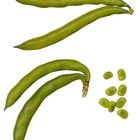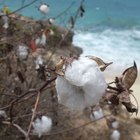
When it comes to the type of string to use, tying a pork roast is much the same as tying any other type of meat. String for culinary purposes is identified by several names, including cooking string, kitchen string and butcher's twine.
Pure and Simple
The important distinction for cooking string is its construction. Synthetic strings will typically melt in the oven, and the color in dyed string will leek into the food. Opt for genuine, pure cotton or linen string that is white or off-white. You do not want any plastic coating on the outside of the string. If you are unsure of the material, conduct a test with a lighted match. Synthetic string will melt and shrivel up, while cotton and linen simply smolders. Avoid jute string, as it is course and hard to work with when tying a pork roast.
Related Articles

How to Bake Fresh String Beans in the ...

How to Make a Braided Round Rasta ...

What Is a Plastic Shoelace Tip Called?

How to Make Indestructible Dog Toys

How to Tell a Real From a Fake Vintage ...

How to Tie a Knot in Sperry Leather ...

How to Make a Homemade Disney Belle ...

How to Clean Polyester Neckties

How to Tie Swimsuit String for Men

How to Tie Shoelace Belts

How to Tie Dye Shoelaces

How to Freeze Fresh Beans Using Pillow ...

How to Stop Satin from Fraying

How to Pull a String Through Sweatpants

How to Decorate Your Knitted Scarf

How to Decorate Graduation Caps

How to Tell If a Fabric Is Cotton

How to Sew Marine Corps Stripes on ...
What Can I Make With Cajun Pork Tasso?

How to Attach a Garland to Reception ...
References
Writer Bio
Wendy K. Leigh is a travel writer and photojournalist from Seattle. She is the Editor of Islands America, a travel website for visiting islands within the United States. She also writes about home design, food and historical architecture. Leigh holds a Bachelor of Arts in English from the University of Washington.
Photo Credits
BananaStock/BananaStock/Getty Images